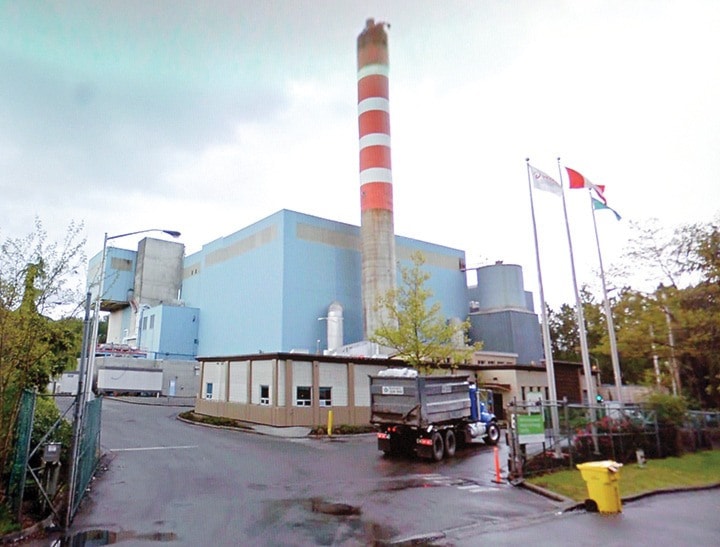Jeff NAGEL and Kevin MILLS
Black Press
A planned new waste-to-energy (WTE) plant for Metro Vancouver might burn not only regular garbage, but also special wastes that are now shipped out of B.C.
That’s the thinking of some Metro directors who argue an advanced new plant might be able to handle dangerous hospital waste, foreign waste from cruise ships or airlines and maybe even oil-contaminated soils or other materials.
A site for the new incinerator has not yet been chosen, but it’s possible it may be in the Lower Mainland. Opponents of such a plan cite serious air pollution concerns in the Valley.
Burnaby Mayor Derek Corrigan is among Metro directors in favour of burning special waste in the new facility, saying it wouldn’t make sense to keep trucking the material to Alberta – emitting more carbon with each trip – if it can be handled here.
Surrey Coun. Marvin Hunt also likes the idea of looking beyond municipal solid waste to see if a new incinerator can end the need to export special waste elsewhere.
“I think we should be dealing with our waste in our own region instead of putting it off to somebody else,” he said.
The idea was raised as Metro directors agreed they need 370,000 tonnes per year of new WTE capacity after the region stops trucking trash to the Cache Creek Landfill in 2016.
That would be the minimum size of the new waste-to-energy plant – about 30 per cent bigger than the existing incinerator in south Burnaby but less than the 500,000 tonnes per year Metro officials previously envisioned.
News of the “special waste” concept was disappointing to Fraser Valley Regional District vice-president and Abbotsford Coun. Patricia Ross, who said it was making a bad situation even worse.
She said the FVRD doesn’t want any waste burned and that Metro is “already going back on what they said before.” Ross is concerned that Metro plans to incinerate what waste remains after recycling and composting had been completed
“What’s left is the most horrible, nasty, toxic stuff that should never, ever be burnt,” said Ross.
She said incineration is not needed and the FVRD is investigating the viability of a “material recovery facility.
“You take all the waste, it gets hand sorted, things are separated, you recycle, you research,” she said.
Items that can be repaired are sold or given away.
Ross said a similar facility is being run in Santa Barbera and is already achieving 86 per cent diversion.
“Metro Vancouver doesn’t think they’re even going to get close to that, but they can. That’s the sad thing, it’s so easily achievable.”
She said if Metro was aggressive and put money into diversion, they wouldn’t need incineration.
The debate to burn even more waste is an example of Metro’s “need to feed the beast to make it financially viable,” said Ross.
Some members of Metro share at least some of Ross’ views.
The special waste debate worries directors like Vancouver’s Andrea Reimer, who wants to keep Metro’s disposal capacity as low as possible on the basis that much more recycling will be possible.
The 370,000-tonne size is based on waste-flow projections and assumes Metro Vancouver’s population will grow to 3.4 million by 2040, and that each resident generates 10 per cent less garbage by 2020.
It also counts on the region hitting its 70 per cent waste diversion target by 2020 – up from 55 per cent now – although officials warn a higher recycling goal of 80 per cent may prove impossible.
Directors also decided the plant must be publicly owned, which could allow a Metro partnership with a local city and a private developer/operator, but not one where the company owns and profits directly from the sale of energy.
There’s been talk before the plant could go to New Westminster, Burnaby, Surrey or the Tsawwassen First Nation within Metro, or to out-of-region sites like Gold River or Powell River, solving the air pollution concerns of opponents in the Fraser Valley.
But the regional district is far from choosing a site.
Metro will ask landowners interested in hosting the plant to step forward next year, and would make the list public next September.
A decision on locating it inside or outside the region wouldn’t come until at least mid-2014.
Meanwhile, Metro aims to shortlist six waste-to-energy firms capable of building the plant and then winnow that further to three finalists who would be evaluated based on their technologies and sites.
The winner would be picked in 2015 and the environmental assessment and permitting would take until late 2016 before construction could start.
The plant wouldn’t open until late 2018.
Part of the long timeline is to allow extensive consultations with the Fraser Valley and any other affected communities.
Part of the long timeline is to allow extensive consultations with the Fraser Valley and any other affected communities.
